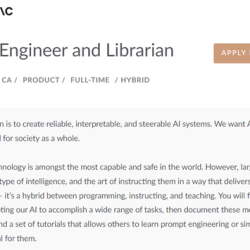我是娜姐 @迪娜学姐 ,一个SCI医学期刊编辑,探索用AI工具提效论文写作和发表。

ChatGPT学术论文写作高质量提示词分享,今天先分享50个,涵盖论文写作、文献综述、研究方法设计、数据分析、学术演讲准备等方面。
1. 论文写作 (Thesis Writing)
1. 为[研究主题]制定一个引人入胜的论文标题,突出其创新性和重要性。
Craft an engaging thesis title for [research topic], highlighting its novelty and significance.
2. 概述[学科]论文的理想结构,确保逻辑流畅和论证连贯。
Outline the ideal structure for a thesis in [discipline], ensuring logical flow and coherent argumentation.
3. 为[研究问题]撰写一个简洁明了的问题陈述,清晰地表达研究目的。
Write a concise problem statement for [research question], clearly expressing the purpose of the study.
4. 设计一个强有力的论文介绍,吸引读者并确立研究的重要性。
Craft a compelling thesis introduction that engages readers and establishes the importance of the research.
5. 总结[研究发现]的关键点,突出其对[学科]的贡献。
Summarize key points of [research findings], emphasizing their contribution to [discipline].
6. 制定一个有说服力的论证来支持[主要论点],使用可靠的证据和逻辑推理。
Develop a persuasive argument to support [main thesis], using credible evidence and logical reasoning.
7. 为[研究结果]撰写一个全面的讨论部分,解释其含义并与现有文献联系。
Write a comprehensive discussion section for [research results], explaining their implications and connecting to existing literature.
8. 创建一个简洁的论文结论,总结主要发现并提出未来研究方向。
Create a concise thesis conclusion summarizing main findings and suggesting future research directions.
9. 为[研究主题]制定5-7个关键词,以增加论文的可发现性。
Formulate 5-7 keywords for [research topic] to increase the discoverability of the thesis.
10. 撰写一个引人入胜的论文摘要,在300字内概括研究的要点。
Write an engaging thesis abstract summarizing the key points of the research in 300 words.
2. 文献综述 (Literature Review)
1. 确定[研究领域]中最相关和最新的10篇关键文献。
Identify the 10 most relevant and recent key publications in [research field].
2. 分析[主题]的现有文献,识别研究差距和潜在的贡献领域。
Analyze existing literature on [topic], identifying research gaps and potential areas for contribution.
3. 综合[理论框架]的不同观点,突出主要争议和共识。
Synthesize different perspectives on [theoretical framework], highlighting major debates and consensus.
4. 评估[方法论]在[研究领域]中的应用,讨论其优缺点。
Evaluate the application of [methodology] in [research field], discussing its strengths and limitations.
5. 比较和对比[主题]的主要研究发现,识别模式和矛盾。
Compare and contrast major research findings on [topic], identifying patterns and contradictions.
6. 创建一个时间线,展示[概念]在[学科]中的演变。
Create a timeline showing the evolution of [concept] in [discipline].
7. 批判性地评价[作者]对[主题]的贡献,讨论其影响和局限性。
Critically assess [author]'s contribution to [topic], discussing its impact and limitations.
8. 总结[研究领域]的当前趋势和新兴方向。
Summarize current trends and emerging directions in [research field].
9. 分类并总结[主题]的主要理论观点,创建一个概念图。
Categorize and summarize major theoretical perspectives on [topic], creating a concept map.
10. 提出一个理论框架,整合[主题]的关键文献见解。
Propose a theoretical framework integrating key literary insights on [topic].
3. 研究方法设计 (Research Methodology Design)
1. 为[研究问题]设计一个合适的研究方法,考虑其优缺点。
Design an appropriate research methodology for [research question], considering its pros and cons.
2. 制定一个详细的数据收集计划,包括工具、时间表和伦理考虑。
Develop a detailed data collection plan, including tools, timeline, and ethical considerations.
3. 选择并证明[研究设计]对于回答[研究问题]的适当性。
Select and justify the appropriateness of [research design] for addressing [research question].
4. 设计一个抽样策略,确保样本的代表性和适当的规模。
Design a sampling strategy ensuring representativeness and appropriate sample size.
5. 制定一个数据分析计划,详细说明将使用的统计方法或质性分析技术。
Formulate a data analysis plan detailing statistical methods or qualitative analysis techniques to be used.
6. 设计用于[研究]的调查问卷或访谈指南,确保问题的有效性和相关性。
Design survey questionnaire or interview guide for [study], ensuring validity and relevance of questions.
7. 制定一个策略来确保[研究]的可靠性和有效性。
Develop a strategy to ensure reliability and validity in [study].
8. 概述[实验设计],包括自变量、因变量和控制措施。
Outline [experimental design], including independent variables, dependent variables, and control measures.
9. 制定一个计划来处理[研究]中可能出现的偏见和局限性。
Formulate a plan to address potential biases and limitations in [study].
10. 设计一个混合方法研究方案,整合定量和定性方法来探索[主题]。
Design a mixed-methods research protocol integrating quantitative and qualitative approaches to explore [topic].
4. 数据分析 (Data Analysis)
1. 作为数据科学家,请概述分析[数据集]的步骤,包括数据清理、探索性分析和统计测试。
As a data scientist, outline the steps to analyze [dataset], including data cleaning, exploratory analysis, and statistical tests.
2. 设计一个流程来识别和处理[数据集]中的异常值和缺失数据。
Design a process to identify and handle outliers and missing data in [dataset].
3. 使用适当的可视化技术,展示[变量]之间的关系,并解释你的发现。
Using appropriate visualization techniques, illustrate the relationships between [variables] and explain your findings.
4. 为[研究问题]选择并证明最合适的统计分析方法,考虑数据类型和分布。
Select and justify the most appropriate statistical analysis method for [research question], considering data type and distribution.
5. 制定一个计划来评估[模型]在[数据集]上的性能,包括验证和测试策略。
Develop a plan to evaluate the performance of [model] on [dataset], including validation and testing strategies.
6. 设计一个实验来测试[假设],详细说明所需的样本量、统计检验和预期结果。
Design an experiment to test [hypothesis], detailing required sample size, statistical tests, and expected outcomes.
7. 创建一个步骤清单,用于在[软件]中进行[分析类型],包括代码片段和注释。
Create a step-by-step checklist for conducting [type of analysis] in [software], including code snippets and annotations.
8. 概述一个方法来解释[机器学习模型]的结果,确保非技术观众也能理解。
Outline an approach to interpret the results of [machine learning model], ensuring understandability for non-technical audiences.
9. 制定一个策略来处理[数据集]中的多重共线性问题,并解释其对结果的潜在影响。
Formulate a strategy to address multicollinearity issues in [dataset] and explain its potential impact on results.
10. 设计一个报告模板,总结[分析]的关键发现,包括方法、结果和局限性部分。
Design a report template summarizing key findings from [analysis], including methods, results, and limitations sections.
5. 学术演讲准备 (Academic Presentation Preparation)
1. 为[研究主题]的20分钟演讲创建一个引人入胜的开场白,吸引听众的注意力。
Create an engaging opening for a 20-minute presentation on [research topic] that captures the audience's attention.
2. 设计一个视觉呈现策略,有效传达[复杂概念],考虑不同的图表和图像选项。
Design a visual presentation strategy to effectively communicate [complex concept], considering various chart and image options.
3. 制定一个框架来组织你的演讲内容,确保逻辑流畅和时间管理。
Develop a framework to organize your presentation content, ensuring logical flow and time management.
4. 创建一组关于[研究方法]的简洁说明,适合在5分钟内口头解释。
Create a set of concise explanations about [research methodology] suitable for verbal delivery in 5 minutes.
5. 设计3-5个关键信息点,概括[研究发现]的核心内容,使听众容易记住。
Design 3-5 key takeaway messages that encapsulate the core of [research findings] for easy audience retention.
6. 制定一个策略来应对可能出现的具有挑战性的问题,特别是关于[争议方面]的问题。
Formulate a strategy to address potentially challenging questions, particularly about [controversial aspect].
7. 创建一个简洁的总结幻灯片,强调研究的影响和未来方向。
Create a concise concluding slide emphasizing the impact of the research and future directions.
8. 设计一个互动环节,鼓励听众参与[演讲主题]的讨论。
Design an interactive segment to encourage audience engagement with [presentation topic].
9. 制定一个计划来调整你的演讲风格,以适应[特定受众],考虑他们的背景和兴趣。
Develop a plan to adapt your presentation style for [specific audience], considering their background and interests.
10. 创建一个检查清单,确保演讲的技术方面(如视听设备)正常运作。
Create a checklist to ensure technical aspects of the presentation (e.g., audiovisual equipment) are functioning properly.
原文链接:https://blog.csdn.net/dinaxuejie/article/details/141205242






















































评论 ( 0 )